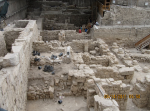THE SIGNIFICANCE OF AD 70
 PMW 2021-060 by Kenneth L. Gentry, Jr.
PMW 2021-060 by Kenneth L. Gentry, Jr.
Today we are so distant from the events of AD 70, so removed from the ancient culture, so little acquainted with the first-century Jewish outlook, and so accustomed to the Christian perspective, we tend to overlook the enormous redemptive-historical significance of AD 70. Those events are not merely another sad instance in the history of “man’s inhumanity to man which makes countless thousands mourn.” They serve not as demonstration of “nature, red in tooth and claw.” Neither do they merely remind us of “the carnage of war, the blood-swollen god.”
But such is mistaken. Rather the devastating events of the Jewish War are the historical manifestations of the furious wrath of the offended God of Israel. Transcendent realities stand back of these temporal events. With Nahum we see the smoke of destruction as the dust clouds from God’s feet (Na 1). We learn that truly “it is a fearful thing to fall into the hands of the living God” (Heb 10:27) for “our God is a consuming fire” (Heb 10:31).
Israel’s failure and God’s response
Jehovah God sent His own Son to his covenant people, but they “received him not” (Jn 1:11). Indeed, they spitefully abused him in defiance of his gracious and loving overtures (Mt 11:28; 21:33-46; 23:34-47; Ac 7:51-53). Consequently, with His rejection, “the sons of the kingdom were cast out” (Mt 8:12), and “the kingdom of God was taken” from them (Mt 21:43).
In the Days of These Kings: The Book of Daniel in Preterist Perspective
by Jay Rogers
This orthodox preterist analysis of Daniel is not a book, but a library. Extremely helpful for the postmillennial orthodox preterist.
For more study materials, go to: KennethGentry.com
Hebrews was written to warn of the disastrous consequences of Jewish Christians apostatizing back into Judaism (Heb 2:1-4; 6:1-4; 10:26-31), just as Jesus had warned (Mt 24:10, 12). It portrays “the day drawing near” (Heb 10:25; cp. Ac 2:16-20,40). This would effect a grand change in God’s redemptive administration — a change that both the author of Hebrews and John liken to “a new Jerusalem” (21:1; cp. 2Co 5:17; Gal 6:15; Heb 12:22; Rev 21:2), which is Christianity (Heb 12:23-25; cp. Gal 4:25-26; Rev 14:1-5).
In Hebrews 12 the writer powerfully presents his conclusion to his book-long warning. After reminding them from whence they had originally come (OT Israel, Heb 12:18-21), he informs them of where they have most recently been (NT Christianity):
“But you have come to Mount Zion and to the city of the living God, the heavenly Jerusalem, and to myriads of angels, to the general assembly and church of the first-born who are enrolled in heaven, and to God, the Judge of all, and to the spirits of righteous men made perfect, and to Jesus, the mediator of a new covenant, and to the sprinkled blood, which speaks better than the blood of Abel” (Heb 12:22-24).
But many are defecting back to Judaism. And at the worst possible time. They were leaving the spiritual, anti-typical, fulfillment realities of Christianity to return to the material, typical, ceremonial world of a now-defunct Judaism. This apostasy occurred when God was about to “shake not only the earth, but also the heaven” (Heb 12:26). The shaking of the “created things” (12:27) speaks of the destruction of the temple system with its “made with hands” ritual implements (9:11, 24; cp. Mk 14:58), which are “ready to vanish away” (8:13; cp. Jn 4:21; Ac 6:14; 7:48; 2Co 3:11; Gal 4:25-30). In place of the OT system, Christianity will remain as a “kingdom which cannot be shaken” (12:28).
Israel’s failure and John’s Revelation
John’s message in Revelation performs the same play but on a different stage and in slightly different dress. John’s new creation presents a new world order: Christianity, which arises from within Israel (Rev 12) and remains after the destruction of the Jewish temple-based system (Rev 11). We know this is John’s point because immediately after describing the new creation in Revelation 21:1–22:5, we read:
“’These words are faithful and true’; and the Lord, the God of the spirits of the prophets, sent His angel to show to His bond-servants the things which must shortly take place. And behold, I am coming quickly…. Do not seal up the words of the prophecy of this book, for the time is near” (22:6-7, 10).
The Harrowing of Hell (by Jay Rogers)
This postmillennial book examines the power of the Gospel, not only to overcome all opposition, but to rise far above the powers of hell. The term “Harrowing of Hell” refers to idea that Christ descended into Hell, as stated in the Apostles’ Creed.
For more Christian educational materials: www.KennethGentry.com
Though even today we await a final, consummational, eternal new creation order (2Pe 3:7-13), we now live in the preparatory, spiritual new creation order established in the first-century. Calvin comments on Isaiah 65:17 noting that the “new heavens and new earth” is metaphorical language that “promises a remarkable change of affairs” when God “restores his Church” so that it “shall appear to gain new life and to dwell in a new world” (Isaiah, ad loc.). Westminster divine John Lightfoot even relates it to the destruction of Jerusalem “which is very frequently expressed in Scripture as if it were the destruction of the whole world” (2:318). We know Isaiah 65 does not speak of the consummate order for it includes child bearing, sinners, death, and curse (Isa 65:20).
Kenneth L. Gentry Jr.'s Blog
- Kenneth L. Gentry Jr.'s profile
- 85 followers



